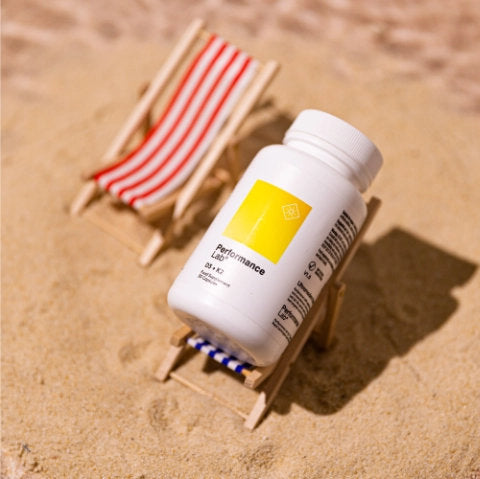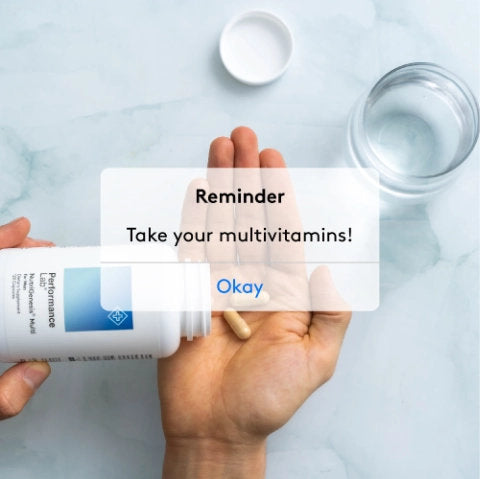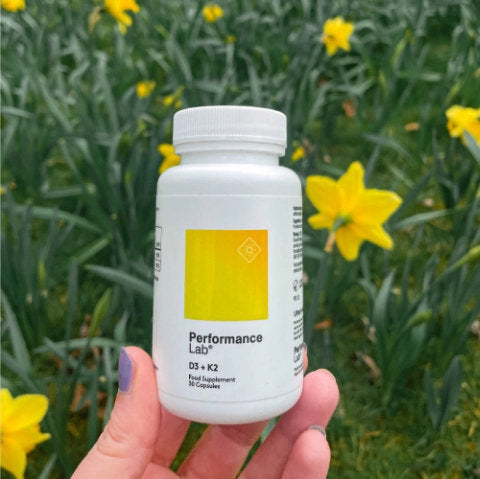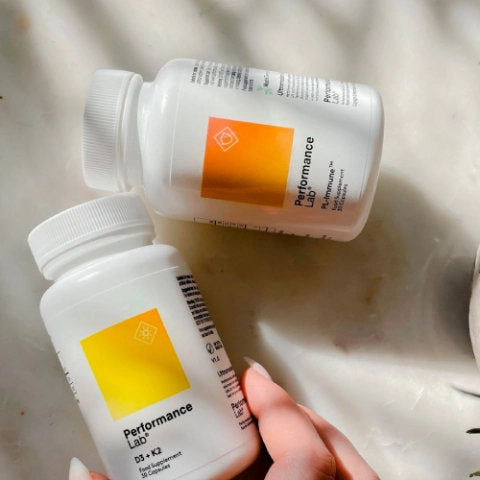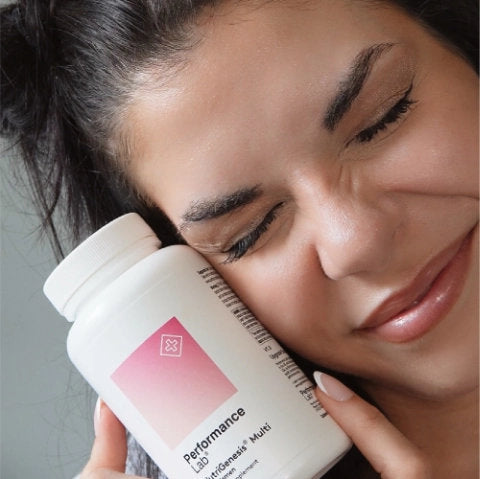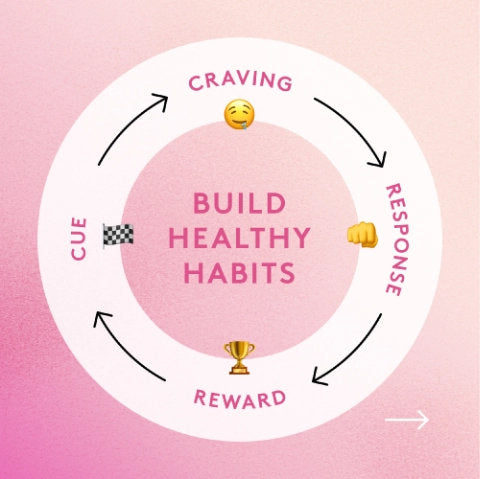When you think about vitamin C, what's the first thing that comes to mind?
Probably oranges and your immune system… right?
Vitamin C has long been regarded as one of the best supplements for immune health (although the orange juice and sugar content—not so much), and while it's great at doing that, it also has many other critical functions in the body—protecting the eyes being one.
If you haven't heard about vitamin C for eye health, you're about to learn everything you need to know about it. And by the end of this article, you'll be itching to get out and get yourself some.
What is Vitamin C?
Vitamin C, also known as ascorbic acid, is one of the few vitamins that cannot be synthesized by the human body and is mandatory for survival.
It's an essential water-soluble antioxidant that plays a role in scavenging free radicals and protecting cells from damage, among other important functions.
Some of which include:
- Collagen formation
- Immune support
- Biosynthesis of L-carnitine
- Increases absorption of iron
- Protein metabolism
- Wound healing
The Role of Vitamin C In The Body
A Potent Antioxidant
One of the most well-established roles of vitamin C in the body is acting as a powerful antioxidant.
Vitamin C donates electrons to molecules, thus making it a reducing agent. All of its known physiological and biochemical actions result from its action as an electron donor; it donates electrons to unstable radical molecules to prevent another compound from being oxidized(1).
The very nature of this reaction means vitamin C itself is oxidized. However, despite forming a free radical, a semidehydroascorbic acid or ascorbyl radical, it is relatively stable and nonreactive compared to others.
When free radicals accumulate in the body and antioxidant status is low (free radicals outnumber antioxidant defenses), the body enters a state of oxidative stress.
Oxidative stress has been linked to many adverse ocular health outcomes, including senile cataracts, age-related macular degeneration (AMD), uveitis, cataract progression, premature retinopathy, keratitis, and ocular inflammation(2).
But interestingly, research supports the idea that consuming greater amounts of vitamin C can increase serum antioxidant levels by as much as 30%(3, 4) and protect against free radical damage.
Partners in Crime: Vitamin C and Vitamin E

This duo is an antioxidant powerhouse. They work together to scavenge free radicals, neutralize them, and prevent them from causing damage to biological structures.
When free radical damage gets out of hand, the risk of chronic disease development increases.
But where vitamin C and E come in handy together is when they actually neutralize a free radical.
In the process of doing so, vitamin E loses its ability to act as an antioxidant, but vitamin C comes along and can regenerate alpha-tocopherol and give it back its function(5).
Studies estimate the regeneration by ascorbate is anywhere from 42 to 60%(6).
Vitamin C and Eye Health
Sjögren (SS) or non-Sjögren syndrome
Recent research has provided a great deal of evidence to suggest that oxidative stress plays a role in the pathogenesis of Sjögren (SS) or non-Sjögren syndrome-related dry eye disease(2).
Studies show that in patients with SS, there is an increased expression of superoxide dismutase (SOD), catalase, and glutathione peroxidase (7), all enzymes that break down various compounds.
Another study suggested that free radical production was associated with cell membrane lipid peroxidation, as well as inflammatory cell infiltration in the ocular surface-lacrimal gland unit(8).
While this is just evidence from a few studies, there is a growing body to support the idea that oxidative stress may have a direct and/or indirect effect on ocular surface health and may play a key role in the pathogenesis of several forms of dry eye.
The premise behind this research is where vitamin C comes into play.
Vitamin C and Dry Eyes
As research suggests inflammation and oxidative stress is one of the underlying mechanisms behind dry eye disease, the potent antioxidant properties of vitamin C may effectively reduce oxidative stress levels and thus reduce the development of eye diseases.
It's also been shown that dietary nutrient deficiencies are involved in the pathogenesis of dry eye syndrome.
Namely, essential fatty acids play a role in the inflammatory process and can mediate levels of inflammation. As well, antioxidants like vitamin C may improve the tear film stability and health of the conjunctival surface(9).
Excessive free radicals can attack the cell's plasma membrane and result in cell damage and death, but they can also damage the epithelial tissues of the conjunctiva, the lacrimal glands, and tear-secreting tissues (10).
Boosting antioxidant intake may help to fight against free radicals and may help conjunctival tissues generate a stable tear film.
One specific study suggests that certain antioxidants—astaxanthin, vitamin C, and vitamin E to be specific, can reduce ROS and oxidative damage.
Astaxanthin acts to inhibit cell viability loss and increases in ROS; vitamin C is a well-known cell-protective natural antioxidant, and vitamin E protects the retina against injury by reducing the formation of ROS(10).
Not just this, but there's ample research to conclude that people with a vitamin c deficiency or chronically low levels of vitamin C have a higher risk of various chronic diseases. Including heart disease, cancer, eye diseases, and neurodegenerative conditions(5).
Sources of Vitamin C

Because vitamin C cannot be synthesized in the body, it must come from one of two sources: diet or supplementation.
In terms of dietary consumption, there's no shortage of vitamin C-rich foods to choose from. Here are some of your best options (from the highest levels to lowest) 1:
- Fruit (strawberries, papaya, kiwi, orange, cantaloupe, mango, grapefruit, melon)
- Grape juice (no sugar added)
- Vegetables (bell peppers, broccoli, kale, Brussels sprouts, snow peas, mustard greens)
Alternatively, vitamin C supplements are widely available in health foods stores.
However, be mindful of consuming large doses, as high-dose vitamin C can cause loose stools.
PRO TIP: We recommend doing the bowel tolerance test to determine your limit. Take 1000mg of vitamin C every hour (keep track of how much you take) until you start to experience loose stools. Knock back 1000mg from the current amount and that is your vitamin C intake tolerance.
The Best Way to Support Eye Health
There's no harm in supplementing with vitamin C or boosting your intake of vitamin C-rich foods, but when it comes to looking out for your eyes, you can't go wrong with combining various supplements to provide maximum support.
Despite vitamin C not playing a sole role in treating dry eyes, combining it with something like Performance Lab Vision may give your eyes the boost they need.

Combining a vitamin C supplement along with Performance Lab® vision, means you're getting six powerful antioxidants and maximizing protection for your eyes.
Performance Lab® Vision includes lutein and zeaxanthin. These two botanical antioxidants help to nourish and reinforce the macular pigment, whilst playing a role in preventing the progression of developing cataracts.
Saffron nourishes macular pigment and boosts blood flow to the eyes. Whilst blackcurrant extract helps with night vision and retina-to-brain signaling speed.
Vision can be taken on its own or stacked with Performance Lab® Vitamin C for enhanced antioxidant support.
- SJ Padayatty, A Katz, Y Wang, et al. Vitamin C as an antioxidant: evaluation of its role in disease prevention. J Am Coll Nutr. 2003;22(1):18-35.
- M Dogru, T Kojima, C Simsek, K Tsubota. Potential Role of Oxidative Stress in Ocular Surface Inflammation and Dry Eye Disease. Invest Ophthalmol Vis Sci. 2018;59(14):DES163-DES168.
- MK Kim, S Sasazuki, S Sasaki, S Okubo, M Hayashi, S Tsugane. Effect of five-year supplementation of vitamin C on serum vitamin C concentration and consumption of vegetables and fruits in middle-aged Japanese: a randomized controlled trial. J Am Coll Nutr. 2003;22(3):208-216.
- LM Popovic, NR Mitic, D Miric, B Bisevac, M Miric, B Popovic. Influence of vitamin C supplementation on oxidative stress and neutrophil inflammatory response in acute and regular exercise. Oxid Med Cell Longev. 2015;2015:295497.
- RA Jacob, G Sotoudeh. Vitamin C function and status in chronic disease. Nutr Clin Care. 2002;5(2):66-74.
- AC Chan. Partners in defense, vitamin E and vitamin C. Can J Physiol Pharmacol. 1993;71(9):725-731.
- J Cejkova, T Ardan, Z Simonova, et al. Decreased expression of antioxidant enzymes in the conjunctival epithelium of dry eye (Sjögren's syndrome) and its possible contribution to the development of ocular surface oxidative injuries. Histol Histopathol. 2008; 23:1477–1483.
- TH Wakamatsu, M Dogru, Y Matsumoto, et al. Evaluation of lipid oxidative stress status in Sjogren syndrome patients. Invest Ophthalmol Vis Sci. 2013; 54:201–210. S Patel, J Plaskow, C Ferrier. The influence of vitamins and trace element supplements on the stability of the pre-corneal tear film. Acta Ophthalmol (Copenh). 1993;71(6):825-829.
- JY Huang, PT Yeh, YC Hou. A randomized, double-blind, placebo-controlled study of oral antioxidant supplement therapy in patients with dry eye syndrome. Clin Ophthalmol. 2016;10:813-820.




